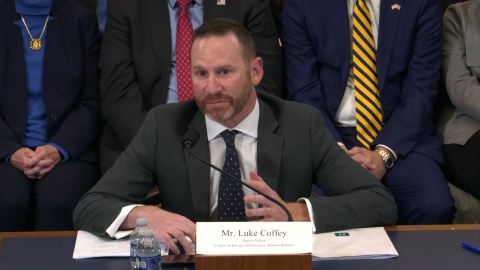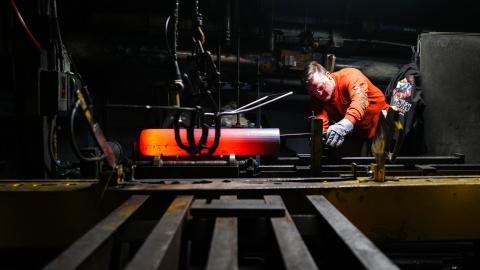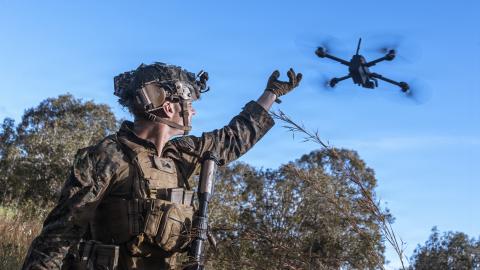The central theme of Secretary of War Pete Hegseth’s recent speech on acquisition reform was that commercial companies and technologies are at the foundation of a strong defense industrial base and military innovation. As he put it, the department wants to harness more of America’s cutting-edge companies to focus their talent and technologies on our toughest national-security problems. New results won’t appear overnight, but the direction launched by Hegseth is the right one.
That’s why defense policymakers should be cautious about a provision now under consideration in the 2026 National Defense Authorization Act (NDAA) that could undercut the dynamism we need in one of our most critical emerging defense sectors: unmanned autonomous systems.
Tucked into the bill is a proposal based on the SkyFoundry Act of 2025, to establish a government-owned innovation hub and production facility that would produce up to one million small unmanned aircraft systems under the oversight of the US Army Materiel Command. The Army recently reiterated this plan to build one million drones over the next 2-3 years.
For many reasons, producing drones at a government-owned facility would be a mistake.
First, directing production to government-owned facilities runs counter to the broader effort now underway to strengthen America’s manufacturing base by fostering a vibrant commercial sector. A central theme of both the first and second Trump administrations has been to revitalize US industry through partnership with the private sector rather than by expanding government production. President Donald Trump’s Made in America initiatives framed manufacturing as a collaboration with business, not a government enterprise.
Consistent with that vision, Trump’s June 2025 executive order on achieving drone dominance focuses on commercialization — advancing drone development, production, and export through industry leadership. Hegseth’s July drone dominance memo reaffirmed these points, directing the Army to accelerate acquisition from commercial suppliers. Even the Army itself has echoed this message, calling for the rapid fielding of low-cost unmanned systems developed by the private sector.
Second, an Army that produces its own drones as opposed to purchasing from the dozens of American companies now in this space could cut our soldiers off from the innovation and rapid adaptation that are essential to winning on today’s and tomorrow’s battlefields. After all, it is the private sector that drives innovation. Deputy Secretary Steve Feinberg’s initiatives have emphasized the need to draw in new companies and commercial innovation so that the Pentagon can source, field, and update capabilities from industry more quickly and at greater scale. Hegseth’s recent speech underscored the same point —lowering barriers to entry for firms so that innovations can reach the department faster.
Third, directing government production in a key sector risks perpetuating the supply chain problem that is already a drag on America’s drone industry. Supply chains for drones are fragile and many of the magnets, key motors, and electronics vital to autonomous systems come from China. Until the United States and its allies can produce these inputs, US companies will remain vulnerable. China has already restricted the export of batteries, motors, and flight controllers to the US, Europe, and Ukraine. Army production of drones would divert limited supplier from American companies, thus reducing the chances of a healthy, competitive sector down the line.
Finally, the track record of the government-owned facilities that make up the so-called “organic industrial base” (OIB) is problematic. Established decades ago under federal law to ensure that the United States could mobilize in wartime, the OIB is burdened by aging infrastructure and outdated equipment. Government Accountability Office reports have repeatedly found that, while some improvements have been made, the depots still face a multibillion-dollar backlog of maintenance and modernization projects — roughly $3 billion by some estimates — and that much of the capital equipment is well past its service life.
Why pour money into an aging system that relies on the government rather than energizing commercial manufacturing? Moreover, the Army’s own modernization leadership has emphasized the importance of facilities that can conduct digital repair, not large-scale serial production.
Some elements of the SkyFoundry proposal could be constructive, if properly adapted. For example, establishing a joint government–industry working group could help identify capability gaps, align investment priorities, and accelerate fielding. The Defense Production Act’s authority to conclude so-called “voluntary agreements” could provide a mechanism for doing this without triggering concerns about collusion. In addition, the government could catalyze faster innovation by offering its facilities to private-sector firms to test, prototype, and develop new technologies — similar to the Department of Energy’s laboratory system. And the SkyFoundry provision to create a hub for lessons learned in recent wars could be useful too.
Of course, the Department of War and the Army have vital roles to play in ensuring that American soldiers have access to the best drones possible. As the department has demonstrated in recent months, it possesses powerful instruments to catalyze the private sector to take on important defense problems. By using its power to make purchase commitments and off-take agreements and a range of other innovation-related authorities, the DoW can help address the Army’s drone shortage while also ensuring that the “valley of death” is not littered with promising drone companies.
But at a time when the entire nation should be focused on expanding production capacity for the industries of the future, this is not the moment to turn inward and build parallel, government-owned manufacturing systems. The government’s role is to catalyze and incentivize, not to replicate what the private sector does best. The goal should be an industrial base that can surge on demand and continuously update hardware and software, ensuring America’s competitive advantage against adaptive adversaries.
The new acquisition philosophy is the right one: Compete for ideas, contract for speed, and buy at scale. Commercial purchase commitments and off-take agreements — not government plants — are the right tools for that.
















